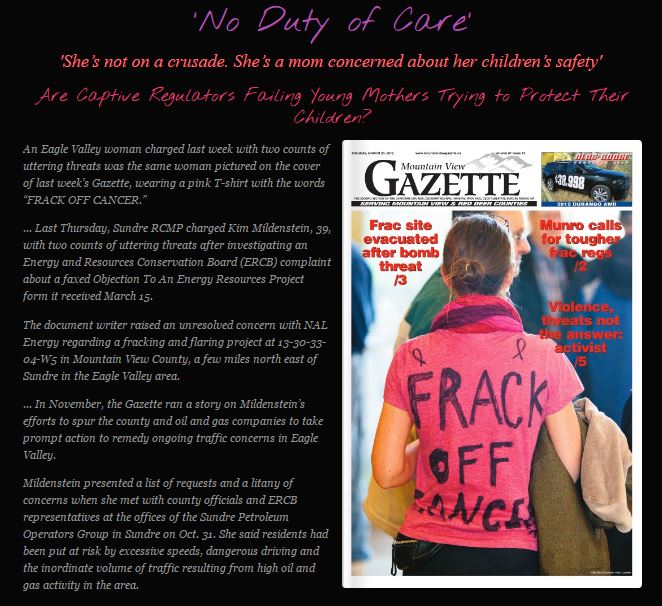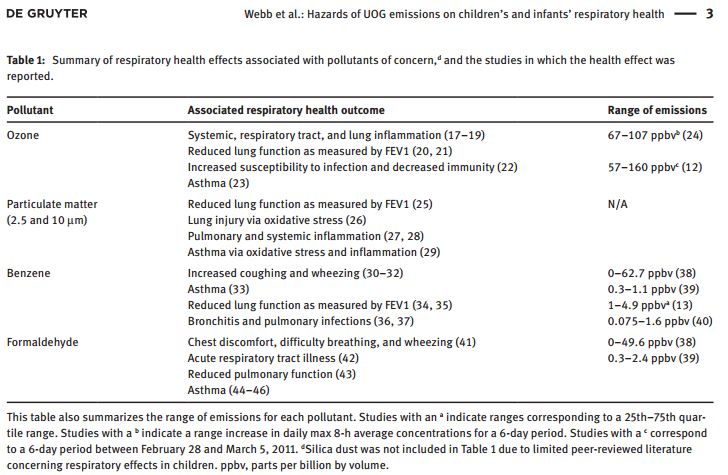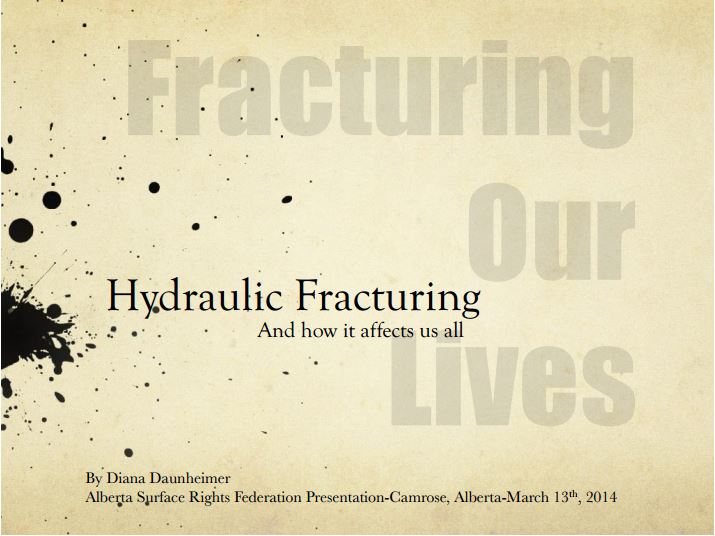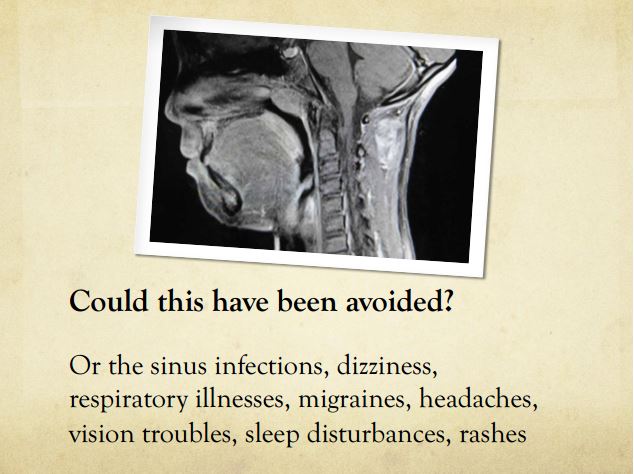Potential hazards of air pollutant emissions from unconventional oil and natural gas operations on the respiratory health of children and infants by Ellen Webb, Jake Hays, Larysca Dyrszka, Brian Rodriguez, Caroline Cox, Katie Huffling and Sheila Bushkin-Bedient, Published Online: May 12, 2016, Received October 12, 2014; accepted February 8, 2016, Reviews on Environmental Health
Abstract:
Research on air pollutant emissions associated with unconventional oil and gas (UOG) development has grown significantly in recent years. Empirical investigations have focused on the identification and measurement of oil and gas air pollutants [e.g. volatile organic compounds (VOCs), particulate matter (PM), methane] and the influence of UOG on local and regional ambient air quality (e.g. tropospheric ozone). While more studies to better characterize spatial and temporal trends in exposure among children and newborns near UOG sites are needed, existing research suggests that exposure to air pollutants emitted during lifecycle operations can potentially lead to adverse respiratory outcomes in this population.
Children are known to be at a greater risk from exposure to air pollutants, which can impair lung function and neurodevelopment, or exacerbate existing conditions, such as asthma, because the respiratory system is particularly vulnerable during development inutero, the postnatal period, and early childhood.
In this article, we review the literature relevant to respiratory risks of UOG on infants and children. Existing epidemiology studies document the impact of air pollutant exposure on children in other contexts and suggest impacts near UOG. Research is sparse on long-term health risks associated with frequent acute exposures – especially in children – hence our interpretation of these findings may be conservative. Many data gaps remain, but existing data support precautionary measures to protect the health of infants and children.
Keywords: benzene; formaldehyde; ozone; particulate matter; silica dust; UOG.
…
…
…
…
…
Conclusion
We conclude that exposure to ozone, PM, silica dust, benzene, and formaldehyde is linked to adverse respiratory health effects, particularly in infants and children. However, the scientific literature examining the direct impact of shale gas and oil development on children is just starting to emerge. In the absence of direct evidence on levels of exposure and adverse health outcomes among infants and children due to UOG air pollution, our focus on key air pollutants and the vulnerability of children serves to identify potential health risks as well as to promote additional research in this area.
Research indicates elevated air pollutant emissions and/or atmospheric concentrations in areas with UOG development as well as increased health risks, driven by pollutants such as benzene. Meanwhile, a growing number of epidemiological studies indicate that oil and gas development is associated with adverse health impacts, such as increased birth outcomes, hospitalization rates, and reported health symptoms per person (2, 160, 161). These initial results are consistent with the existing body of epidemiology that observes the impact of air pollutant exposure on children more generally. We believe that protecting children’s health is a social, scientific, and ethical priority. Large-scale and long-term epidemiological studies are needed but we strongly recommend precautionary measures at this time, in order to protect the health of infants and children.
Fracking Chemicals Linked to Respiratory Health Risks by Centre for Environmental Health, May 12, 2016
Oakland, CA-A new review released online today in the peer-reviewed journal Reviews on Environmental Health shows that a clearer scientific understanding of the public health and environmental impacts of modern unconventional oil and natural gas development is emerging and that chemicals from unconventional oil and gas (UOG) operations, including from fracking, pose serious health risks, in particular to infants and young children.
The review finds that at least 5 chemicals used and produced by UOG and fracking operations have well-known respiratory health effects for infants and children. Following a growing number of epidemiological studies indicating that oil and gas development is associated with adverse health effects, such as increased adverse birth outcomes, hospitalization rates, and reported health symptoms per person, this comprehensive literature review adds to the growing scientific concern that fracking poses unacceptable health risks to nearby communities.
The paper, “Hazards of UOG emissions on children’s and infants’ respiratory health,” reviewed the literature around chemicals associated with fracking and other UOG methods.
“Infants and children are more vulnerable to negative health impacts of pollutants found near UOG sites. As highlighted in this review, these pollutants can create greater risks for asthma and other respiratory diseases in in those children living, playing, and going to school near these sites, said Katie Huffling of the Alliance for Nurses of Healthy Environments, one of the authors of the review. “Protecting children from these pollutants needs to become a priority in areas with UOG.”
“Our article presents a discussion of current knowledge of health risks from exposure to UOG operations to vulnerable unborn developing babies and young children. This information is derived from many recent peer-reviewed studies. We seek to share our knowledge through public education.” said Sheila Bushkin of the Institute for Health and the Environment at the State University at Albany, the senior author of the review.
“Notable information gaps remain and we still need better data to characterize the frequency, duration, and degree of exposure for children. However, the science linking adverse health effects to air pollutants we know to be associated with oil and gas development processes, coupled with the emerging epidemiological research on shale gas, clearly warrants further investigation into how this vulnerable population may be at risk.” said Jake Hays, Director of the Environmental Health Program at PSE Healthy Energy and one of the authors of the review.
The review released today, co-authored by CEH’s Research Director Caroline Cox and Healthy Energy Sciences & Advocacy Manager Ellen Webb, found serious health risks, including:
- Asthma: Some evidence from studies suggests that ozone, particulate matter and ambient benzene and formaldehyde is implicated in the induction of asthma. A strong association between ozone exposure and hospitalizations for adverse respiratory health effects have been reported, particularly for an increase in emergency department visits and hospitalizations due to asthma.
- Reduced lung and pulmonary function: Air pollution can cause a range of reactions in human body including reduced lung function associated with inhalation of benzene, formaldehyde, particulate matter and ozone.
- Increased susceptibility to infection and decreased immunity: In addition to causing changes to the respiratory system, chemicals such as ozone are believed to affect immune response leading to more lung infections. Studies have reported an association between ozone and an increase in susceptibility to infection.
- Chest discomfort, difficulty breathing, wheezing and coughing:In addition to being a carcinogen, benzene is also a respiratory irritant and can pose serious risks to respiratory health. In children, benzene and formaldehyde exposure has also been associated with adverse respiratory health outcomes, including increased occurrence of cough and wheezing.
- Lung and pulmonary inflammation: Some fracking chemicals, especially VOCs mixtures may be responsible for increased lung inflammation.
“To protect the health of children and infants and families nationwide, state and federal agencies should adopt a precautionary approach when establishing permitting rules and standards for UOG development and production, this includes fracking,” said Ellen Webb, lead author of the review. “Families deserve protection and children deserve a healthy future. More research is needed, but in the meantime, regulatory changes are needed that will protect children and infants from harmful chemicals that could have life-long health implications.” [Emphasis added]
Fracking’s Air Pollution Puts Infants and Children at Risk of Developing Heart, Lung Problems: New Study by Sharon Kelly, May 12, 2016, desmogblog.com
A newly published peer-reviewed study concludes that air pollution from fracking puts people’s lungs, hearts, and immune systems at risk – and that the health risk are particularly pointed for young children and infants.
The study – the first to specifically focus on how shale oil and gas drilling affects children ability to breathe – concludes that starting in the womb, children’s developing respiratory systems are particularly at risk from five airborne pollutants associated with fracking and drilling.
“We conclude that exposure to ozone, [particulate matter], silica dust, benzene, and formaldehyde is linked to adverse respiratory health effects, particularly in infants and children,” the researchers wrote in the study, titled “Potential Hazards of Air Pollutant Emissions from Unconventional Oil and Natural Gas Operations on the Respiratory Health of Children and Infants” and published in Reviews on Environmental Health.
“While the rapid growth of this industry was undertaken without substantial public health research, there are now numerous publications clarifying health risks and, increasingly, health outcomes,” they wrote, adding that since 2013, over 560 peer-reviewed studies on unconventional oil and gas extraction’s impacts have been published, representing over 80 percent of the scientific literature on the topic. In other words, in the last few years, the risks from fracking have become much more heavily studied – and the results show good reason to be concerned about how people’s health is being affected.
Based on the risks associated with breathing air laced with the five most-studied pollutants, the researchers expressed concern about fracking near homes, day cares, and schools. “We recommend that at a minimum, one-mile setbacks should be established between drilling facilities and occupied dwellings such as schools, hospitals, and other dwellings where infants and children might spend a substantial amount of time,” they wrote.
But state rules generally fall far short of that buffer zone. There is no national data available on how many schools or childcare facilities are now within a mile of a fracked well, in part because there are no federal regulations requiring the industry to track that data. Each individual state sets different rules controlling how far well pads must be from schools – and those rules vary widely across the U.S.
All told, over 17 million Americans live within a mile of an active oil or gas well – but the precise number of children within the one-mile zone nationwide has never been formally tallied, and not all of those wells are the unconventional oil and gas wells that the new study specifically focused on.
In Pennsylvania, the researchers noted, over 53,000 children under 10 live or attend school within a mile of a permitted fracked well. A separate mapping project, conducted by a group called Healthy Schools Pennsylvania, discovered more than 40 pipeline compressor stations – notorious for spewing pollution into the air – within a mile of the state’s schools, and found that one school district that had over 40 oil or gas wells within a mile of its schools. In Pennsylvania alone, over 400 documented violations of state environmental laws occurred at wells located within one mile of a school or a day care, and 13 violations occurred at wells less than a mile away from a hospital.
And it’s not just an East Coast issue. In four northern Colorado counties, researchers from the Western Resource Advocates found 32 schools within just 1,000 feet of a fracked well in 2012.
“Our research shows that the current setback distances between fracked gas wells and homes, schools, and health care centers are not enough to protect public health, especially children,” Dr. Marsha Haley, an oncologist at the University of Pittsburgh Cancer Institute, told the Pittsburgh Post-Gazette after she authored a different peer-reviewed study. That study, published on Feb. 19 in the National Institute of Environmental Health Services journal, concluded that current set-back standards not only put children’s long-term health at risk from air emissions, but are also not strict enough to protect against risks from accidents and explosions.
Black and Latino parents may have particular reason to be concerned about the risks associated with oil and gas drilling and fracking, an investigative report by ThinkProgress in 2014 found.
“In California itself, 79 percent of the more than 350,000 kids who live within a mile of an oil and gas well are non-white, while 60 percent are Hispanic,” reporter Emily Atkin wrote. “Coincidentally or not, some parents of Sequoia kids [in a town where 82 percent of residents are Hispanic] have complained of their kids suffering headaches, dizziness, and nausea. More alarming complaints have popped up as well, according to Juan Flores and Madeline Pano of the Center for Race, Poverty and the Environment, who both work closely with families in Shafter: A 12-year old student experiencing epileptic attacks; a nine-year-old student diagnosed with prostate cancer; an 11-year-old student who died from a mysterious illness that four hospitals could not diagnose.”
“Community members are questioning, why are these things happening in this community?” Flores told ThinkProgress. “Why are kids getting sick?”
The new study, the most comprehensive review of the literature to date, comes on the heels of several in-depth looks at issues related to fracking and child health, including a December 2014 study linked fracking-related chemicals to infertility, low birth weights and impaired growth in the womb, as well as a litany of potential health problems after children are born.
“People really near unconventional oil and gas and fracking sites and those who work in the fracking industry have the right to know the chemicals that are being used that may pose health threats, especially to vulnerable populations like women and children,” Ellen Webb, energy program associate at the Center for Environmental Health, told U.S. News and World Report when her 2014 study was published. “Given the lack of study and understanding of all the chemicals that are being used, we can’t know the extent of the risks.”
As troubling as the new study’s results might be, they represent only the tip of the iceberg, since most of the chemicals used by the oil and gas industry for fracking remain gravely under-studied.
In part, that’s because little health testing is generally required under the Toxic Substances Control Act, the main federal law that covers chemical safety – including many chemicals used for fracking, a recent report by The Partnership for Policy Integrity found.
Out of 99 chemicals that researchers selected for review, only two had health studies available in the public docket (and in ten cases, companies claimed to have provided that information, but the health data was in fact missing or labeled confidential). Although the Environmental Protection Agency expressed concerns about potential health impacts in 88 cases, they only requested health studies for five of the chemicals – and went on to approve virtually all of the chemicals for manufacture.
“Chemical companies and the EPA are basically conducting a chemical experiment on the general public,” said Partnership for Policy Integrity Senior Counsel Dusty Horwitt.
And while there are efforts underway in Congress to revise the laws, those efforts fall far short of the mark, Mr. Horwitt said. “Chemical reform bills that have passed the House and Senate do not fix the problem.” Horwitt added. “Congress and President Obama need to fix the law to ensure that chemicals are regulated with rigorous testing and openness so that citizens can be protected and informed.”
Meanwhile, the risks specifically associated with fracking have begun to draw the attention of politicians at the national level.
“The toxic chemicals used in fracking are known to cause lung cancer and birth defects,” presidential candidate Bernie Sanders wrote in an April 18 op-ed. “If we are serious about safe and clean drinking water and clean air, if we are serious about protecting the health of our children and families, and if we are serious about combating climate change, we need to phase out fracking nationwide.” [Emphasis added]
New Fracking Study Finds Children at Greater Risk of Respiratory Health Problems by Lorraine Chow, May 12, 2016, Ecowatch
[Refer also to:
…
Bob Willard, Senior advisor at the Alberta Energy Regulator, agreed to speak about current regulations.
David Kattenburg: Why aren’t these things being monitored for in the gases that are coming out from flaring and incineration stacks?
Bob: The long list that you’ve identified would be the responsibility for monitoring of not only the Alberta Energy Regulator, but the Environment department themselves, and I would direct you once again to ESRD for them to identify what their plans are relative to updating those guidelines.
David: I have actually, I’ve tried valiantly I’d say to try to get them to explain to me why they have these guidelines that say all industry MUST conform to these guidelines, and then I said well why does directive 60 of the Alberta Energy Regulator only establish monitoring requirements for sulfur dioxide and he said: “speak to the Alberta Energy Regulator.”
Bob: Um, it is important, and this is something the Energy Regulator does lead, is capturing the metrics of the volumes of material, so we do have good metrics as to the volumetrics.
David: But essentially nothing about the composition of those gases, other than sulfur dioxide.
Bob: A totally accurate composition, I would certainly volunteer that no, we do not have a totally accurate comprehensive information on the flare composition rather, we have it for the uh volumes, but not necessarily for the compositions.
Family To Do List by FrackingCanada:
What care do Albertans get from the AER? “No Duty of Care”

Gag Kind of Health “study” in Alberta?
Buyout packages allegedly silence Albertans struck with industry-related cancer
In Alberta, are frac cancer connections bribed silent?
Trican Donates $5 million for cancer research
Frac Company Trican Donates $5 Million to Fight Childhood Cancer ]













